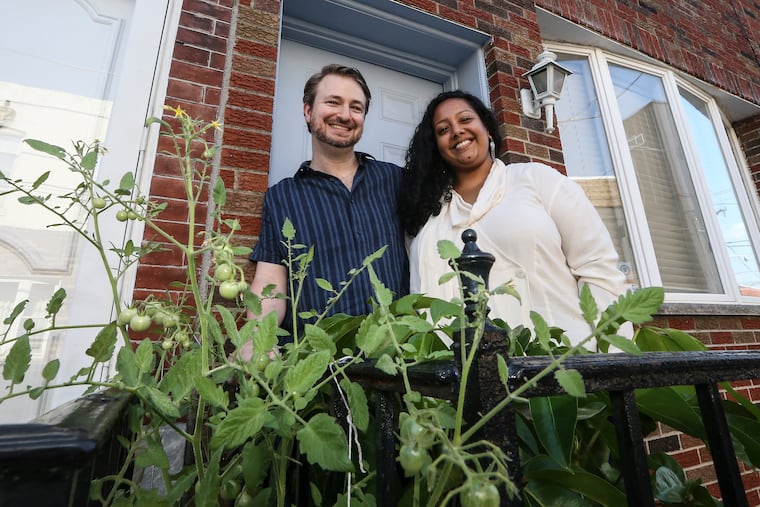Cell phone data show Philly attracting residents from suburbs and Brooklyn
Some Americans, at least, appear to not be fleeing cities but simply trying to find more affordable urban options.

By the beginning of 2021, Warren Dobney and Tessa Vithayathil were tired of living in New York City.
Their two-bedroom apartment in Brooklyn’s Ditmas Park cost them $2,200 a month, and they knew it would soon be going up. The sound of traffic permeated their home. For that price, they wanted something quieter — but they didn’t want to move to the suburbs.
The pair wanted walkability, affordability, and diversity. They considered such cities as Denver, but as a mixed-race couple, they found those places too homogenous.
What’s a city-minded couple to do?
“We were exhausted with New York for a variety of reasons and felt that Philly checked a lot of the boxes that we prefer in cities,” said Dobney, 39.
» READ MORE: Philly had its largest one-year population decline since 1975: See charts that show the factors
Dobney and Vithayathil are part of a larger trend of in-movement to Philadelphia from New York, according to a white paper from the data company Placer.ai, which works with such organizations as the Center City District to analyze population movements. Using an analysis of cell phone location data, the company studied where Americans have been moving during the pandemic.
They found that although Philadelphia lost population consistently for the first year and a half of the pandemic, since mid-2021 the picture has been more mixed. Between April 2021 and April 2022, the city population grew by 0.8%, while Brooklyn, Chicago, and San Francisco haven’t enjoyed a single month of population gain since March 2020.
New Philly residents mostly came from the city’s surrounding counties, with Delaware and Bucks leading the way. But New York (Manhattan), Kings (Brooklyn), and Los Angeles were all in the top 10 counties of origin, too. Some Americans, at least, appear to not be fleeing cities but simply trying to find more affordable urban options.
Why Philly looks good
“Most of the urban centers, especially in the Northeast [and] Northwest, were seeing pretty significant declines” in population during the pandemic, says Ethan Chernofsky, vice president of marketing at Placer.ai. “But Philadelphia sits more on that positive side of the spectrum.”
In comparison with those cities, Philadelphia enjoys the advantage of being the rare dense urban center that is relatively affordable for middle-income households. An obvious draw for former New Yorkers such as Dobney is the cheaper cost of housing. His family is paying $1,800 a month to rent a 1,200-square-foot rowhouse near Passyunk Avenue in South Philadelphia. That’s a substantial discount for about twice the amount of space they had in their Brooklyn apartment.
“We don’t own a car, so it was important that we lived somewhere with decent transit and the type of dense urban living where things are walkable,” Dobney said.
“We were exhausted with New York for a variety of reasons and felt that Philly checked a lot of the boxes that we prefer in cities.”
Three years ago, they wouldn’t have been able to move. Then, during the pandemic, Dobney’s wife’s job went remote. The company allowed her to move to another city, as long as she could still easily get back for the occasional meeting. Dobney got a new job in Philadelphia, teaching in a GED program. He commutes on the Broad Street Line.
Suburban influx
Dobney’s relocation to a new state is not the norm. Despite predictions early in the pandemic that COVID-19 and remote work would have a dramatic effect on where people live, Placer.ai’s findings show that, for the most part, people stayed where they are. When they did move, it tended to be to nearby areas. Most of the people who left San Francisco, for example, remained in California.
“The costs of moving to another state generally outpace the amount of savings the average American has,” said Chernofsky, who was the report’s lead author. “Those who are able to move have slightly higher incomes. But even in this crazy situation, it wasn’t a large-scale mass exodus.”
In the Northeast, where states are smaller and borders closer, Placer.ai saw more movement across state lines like Dobney’s shift from New York to Philadelphia. Still, the company’s paper shows that most of the new residents are moving to the city from the immediate region.
Devin Bulwicz, 27, bought his first house in Philadelphia in May. During the pandemic, he’d been living with his parents in Montgomery County’s Collegeville, saving money. His job is based in the suburbs, but it’s now fully remote. Even if he has to go back, Bulwicz said he’d be willing to reverse commute.
“Philadelphia just makes the most sense,” said Bulwicz, who moved to east Kensington for its transit access and proximity to the restaurants and nightlife in Fishtown. “I’m smack dab in the middle of all the action.”